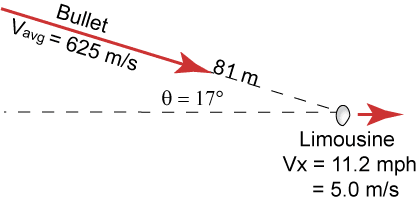|
Mr. Rogers' AP Physics C: Projectile motion Problems |

JFK Problem
President John F. Kennedy, was fatally wounded when a bullet struck the back of his head on Friday, November 22, 1963, in Dallas, Texas, at 12:30 p.m. CST. At the time, he was riding in an open limousine moving away from the gunman at a horizontal velocity of 11.2 mph (5 m/s). According to the official story put out by the Warren Commission, the fatal shot was one of three fired by lone assassin Lee Harvey Oswald from the sixth floor of the Texas School Book Depository. The first shot apparently missed, the second struck Kennedy in the back at the base of his neck, and the third in the head from a distance of 81 m.
The Warren Commission findings were immediately rejected by various conspiracy theorists who have frequently claimed that the required level of marksmanship would have been virtually unattainable and the required firing rate (5.6 to 8.3 seconds from first to third shot, depending on whose estimate one believes) impossible for the World War II surplus bolt-action rifle* Oswald supposedly used.
While a simple projectile motion analysis cannot rule out a conspiracy, it can shed light on the difficulty of the shot. Movement of the target and bullet drop due to gravity would both make a head shot more difficult.
Calculate the time required for the bullet to reach its target. Assume Kennedy is stationary, the bullet travels in a straight line from the point where it's fired to the target, and that there is no air resistance. Admittedly, the path of the bullet will not be in a straight line, but if the time is short the assumption will introduce only a small error.
Next calculate the amount the bullet would drop below a straight line path during the time of flight calculated above, as well as the horizontal distance Kennedy would have moved. From this distance calculate how far below the aiming point the bullet would impact. Add the bullet drop to this distance. This total gives an idea of the possible errors in the vertical dimension between the point of impact and point of aim.
Is the error described above likely to produce a complete miss? Keep in mind that Oswald was an ex-marine with marksmanship training and had practiced shooting his WWII surplus rifle at a local shooting range. He steadied the rifle on a large box as he fired at Kennedy and would have known to aim a little high.
As for the firing rate, numerous tests by various groups have demonstrated that when starting the clock on the first shot, two additional shots can easily be fired within even shorter 5.6 second time estimate. Entertainers Penn and Teller have made a popular video demonstrating the it.
* 6.5 x 52 mm caliber Carcano rifle with a 4x telescopic gun site firing Western Cartridge Co. ammunition with a 160 grain (10.37 g) round nose bullet with a muzzle velocity = 700 m/s and a velocity at 100 yards of 550 m/s. The estimated average velocity would be about 625 m/s.
Solution
Assuming constant velocity over a straight line path yields:
t = d / v
= (81 m) / (625 m/s)
= 0.13 s
If the bullet were dropped, it would fall a distance y as follows:
y = 1/2ayt2
= 1/2 (9.8 m/s2) (0.13 s)2
= 0.083 m
During the time the bullet traveled, the limousine would move xL as follows:
xL = v t
= (5 m/s) (0.13 s)
= 0.65 m
The motion of the limousine would cause the bullet to strike below the original aiming point by Dy as follows:
Dy = xLsin (17°)
= (0.65 m) (.294)
= 0.19 m
Combining both the bullet drop and limo movement errors indicates that the bullet would have dropped about 27 cm or about 11 inches. Assuming that the rifle sights were not adjusted to compensate for bullet drop and that Oswald had aimed near the top of JFK's head, the bullet would have struck JFK in the back near the base of the neck. Most likely, the rifle sights would have been adjusted to hit the target at 100 yards (91 m). In this case, only the motion of the car would have significantly mattered. It would have caused the bullet to strike low by about 7.5 inches.
Neither the bullet drop due to gravity or the motion of the limousine would have been likely to cause a shooter to miss the target. Hitting a slow moving target 81 meter away would have well within the skill level of an ex marine or for that matter a deer hunter.